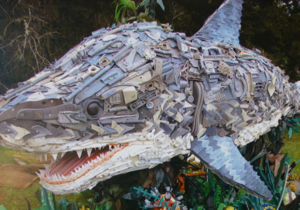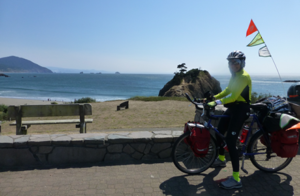Harvesting Plastic From The Pacific Ocean For Art
 By Frosty Wooldridge
By Frosty Wooldridge
April 6, 2023
You never know what you’re going to see on your bicycle while riding down the West Coast. It could be dolphins “surfing” the waves while you pedal along an unknown beach. You might sit on the edge of a cliff to watch 10 pelicans flying in a line across the surf. At some point, you might see 200 seagulls gathered in one spot in a secluded cove. Out beyond the surf, whales blow 30-foot columns of spray when they surface for air.
 (A shark created totally from ocean plastic washed up on Oregon beaches.)
(A shark created totally from ocean plastic washed up on Oregon beaches.)
Your pedaling efforts render many rewards. The Oregon coast may be one of the prettiest, if not most unusual in North America. High cliffs, white sandy beaches, towering redwoods, quiet coves, waterfalls, endless sea life, light houses and centuries-old sailing ports.
We rolled into Bandon, Oregon featuring two sections of a small coastal town. We pedaled through New Bandon with its modern stores, apartments and homes, and “Old Bandon” right out of a 1900’s picture-book of three-masted schooners, old sailor’s bars and piers that jut out into the water.
Old Bandon features an arching sign over the roadway leading into that section of the city. On our right, a pedestal featured a plastic fish made up of hundreds of plastic pieces. It featured every color of the rainbow and then some. We pedaled up the main drag before taking a right turn along a row of buildings.
“Hey,” said Sandi. “Let’s check out this “Washed Ashore” business.”
“Looks different to me,” I said, parking my bike against the building frame.
When we walked into the store, a huge plastic skeleton of a whale, made up of gallon plastic milk jugs ushered us into this unusual store. On the right, hundreds of plastic pieces of junk resembled a jellyfish. On the left, a huge bird made of plastic pieces seemed to flap its wings, trying to get airborne. In the back, a half dozen women and several guys worked on plastic collages. Each carried a specific theme.
Plaques showed that humans have tossed 5.5 trillion pieces of plastic into the planet’s oceans over the last 50 years. Humans continue tossing 8 million pieces of plastic into the oceans every day of the year. An average of 46,000 pieces of plastic float on every square mile of the Earth’s oceans. Plastics now have sunk into the deepest parts of the oceans. As some plastic break down, they find their way into the food chain where fish eat them.
 One plaque spoke about the “Great Pacific Garbage Patch” with 100 million tons of plastic floating in an area the size of Texas…about 1000 miles west of San Francisco. It runs 30 to 60 feet deep in places. It kills millions of seabirds, whales, dolphins, turtles and many other marine creatures. It’s jamming up reefs all over the world.
One plaque spoke about the “Great Pacific Garbage Patch” with 100 million tons of plastic floating in an area the size of Texas…about 1000 miles west of San Francisco. It runs 30 to 60 feet deep in places. It kills millions of seabirds, whales, dolphins, turtles and many other marine creatures. It’s jamming up reefs all over the world.
“This is really quite depressing,” Sand said.
“Yeah, I’m not too thrilled to read about all this human destruction of the oceans,” I said.
“This lady Angela Pozzi started this artwork in 2010,” I said. “Over 14,000 volunteers picked up 300 miles of Oregon coastline, and 30 tons of plastic were transformed into artwork. She’s trying to educate the public as to the damage plastics do to ocean life and marine creatures. She organizes it through WashedAshore dot org.”
For someone like me who has picked up over 1,000,000 pieces of trash on six continents during my lifetime, it’s particularly painful. I began scuba diving in the Florida Keys as a teenager. I saw pristine reefs, perfect sandy bottoms of the Gulf of Mexico and the Atlantic. Today, I’ve witnessed plastic in all the oceans where I have been diving. It’s painful visually as well as ecologically. I hope at some point, humans develop plastic from corn or any other biodegradable sources. In the meantime, we need a 50-cent deposit-return law, internationally. That would solve a great deal of the tossing of plastics.
We spent the rest of the day walking on the piers, watching the crab people throw their crab cages into the water, and enjoying the artwork presented along the fence-line of the pier…all by little kids painting ocean scenes.
In the afternoon, we grabbed our bikes for the ride south. I am thankful for women like Angela Pozzi, 14,000 volunteers who keep picking up the coastline in Oregon, and those who pick it up around the world. I salute anyone who cares about our planet and for all animal and plant life sharing this planet with us.
The one thing about being on tour on your bicycle, you run into unexpected people caring about things that you didn’t really know about until you ran across them. For certain, I love the Natural World and I do everything I can to help all plant-life, all animals, all birds, and all living creatures on this planet. We’re all in this together.
© 2023 Frosty Wooldridge – All Rights Reserved
E-Mail Frosty: frostyw@juno.com